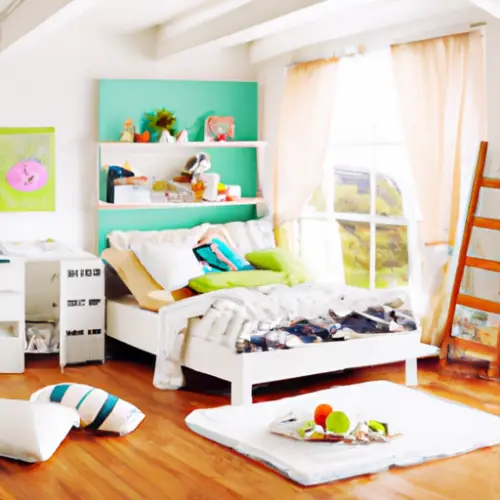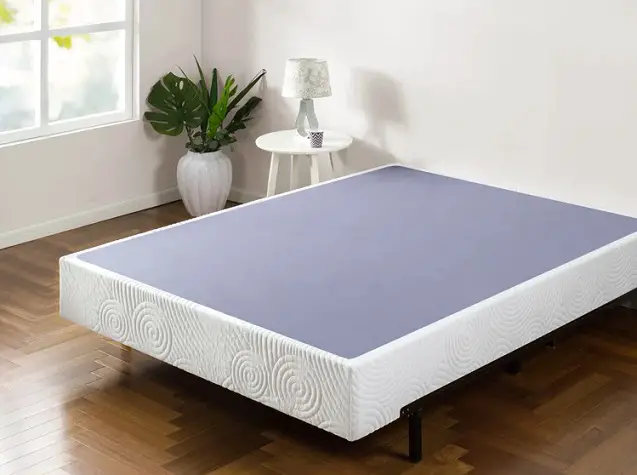As I stepped into my college dorm room for the first time, I immediately knew that I had a limited space to work with. Determined to maximize every inch, I began to consider lofting my bed.
It seemed like a great solution to create much-needed space for studying, hanging out, and storing my belongings. However, after weighing the pros and cons of lofting my bed, I realized that while it could provide extra comfort and functionality to my cramped space, it also came with its fair share of drawbacks.
Let’s explore the benefits and drawbacks of lofting your bed in a dorm room.

Table of Contents
Pros of Lofting Your Bed
Increased floor space
Lofting your bed can instantly create more floor space in your dorm room. By raising your bed off the ground, you can utilize the area underneath for other purposes such as a study desk, storage drawers, or even a mini-fridge.
This extra space can make your room feel more open and less cluttered, allowing for easier movement and a more functional living area.
More functional living area
With a lofted bed, you have the freedom to design your dorm room layout in a way that maximizes functionality. By taking advantage of the vertical space, you can create dedicated areas for studying, relaxing, and socializing.
For example, you could place a cozy seating area underneath your bed, complete with a small table and some cushions, providing you with a comfortable spot to hang out or entertain guests.
Additional storage space
One major advantage of lofting your bed is the extra storage space it provides. Dorm rooms are notoriously lacking in storage options, and lofting your bed can be a clever solution.
You can incorporate storage bins or drawers underneath your bed, where you can neatly store clothing, books, or other personal items. This not only helps to declutter the rest of your room but also keeps your belongings easily accessible and organized.
Improved study environment
By lofting your bed, you can create a more conducive study environment. Utilizing the space underneath your bed for a dedicated study area allows you to have a designated space to focus on your academic work.
You can set up a desk with a comfortable chair, proper lighting, and necessary supplies. This separation of your study area from your sleeping area can help minimize distractions and increase productivity.
Cons of Lofting Your Bed
Difficult to access
One of the downsides of lofting your bed is the difficulty in accessing it. Climbing up and down a ladder or staircase to get in and out of bed may be challenging, especially for individuals with mobility issues or those who are not used to navigating elevated sleeping arrangements.
It is important to consider your physical abilities and comfort levels before deciding to loft your bed.
Limited headspace
Lofted beds typically have limited headspace, especially if the dorm room ceiling is low. This can be inconvenient for taller individuals who may find it uncomfortable to sit or move around in bed without bumping their heads.
It is essential to measure the distance between the mattress and the ceiling to ensure that there is enough clearance for you to maneuver comfortably.
Potential safety hazards
Lofting your bed introduces potential safety hazards, particularly if the structure is not properly installed or if safety precautions are not followed. The risk of falling from an elevated bed is a concern, especially during sleep or when using a ladder or staircase.
It is crucial to ensure that the bed frame is securely anchored and that the ladder or staircase is sturdy and well-maintained. Additionally, it is important to adhere to weight restrictions to prevent the bed from collapsing or becoming unstable.
Restricted privacy
Lofting your bed may impact your privacy, as the open space beneath the bed is visible to anyone in the room. This can be a concern if you value privacy or if you have a roommate with different schedules or preferences.
It is crucial to establish open communication with your roommate and discuss any concerns or potential conflicts regarding privacy before lofting your bed.
Installation and Adjustability
Ease of installation
Most loft bed kits come with easy-to-follow instructions, making the installation process relatively straightforward. With the right tools and a bit of patience, you can set up your loft bed within a few hours.
It is essential to carefully read and follow the instructions to ensure proper installation and avoid any safety issues. If you are uncertain or uncomfortable with DIY projects, consider seeking assistance from a friend or professional.
Adjustability options
Some loft bed systems offer adjustability, allowing you to customize the height and configuration based on your preferences and room layout. This flexibility can be beneficial if you have specific storage or functional needs that may change over time.
Adjustable loft beds are especially useful in dorm rooms where different roommates may have varying requirements or if you anticipate rearranging your dorm room throughout the year.

Cost Considerations
Initial cost
The cost of lofting your bed will depend on various factors such as the type of loft bed system you choose and the quality of materials. Basic loft bed kits can range from around $200 to $500, while more elaborate and customizable systems can cost upwards of $1000.
It is important to factor in this initial cost when budgeting for your dorm room setup.
Additional expenses
In addition to the initial cost of the loft bed system, there may be additional expenses to consider. This can include any necessary tools for installation, bedding accessories specific to loft beds (such as bed railings or customized sheets), and any potential modifications or repairs that may be needed over time.
It is advisable to have a clear understanding of these potential expenses and factor them into your budget.
Maintenance and Upkeep
Cleaning challenges
Lofted beds can present cleaning challenges, particularly when it comes to accessing and maintaining the area beneath the bed. Dust and debris may accumulate over time, requiring regular cleaning and maintenance.
It may be necessary to move or temporarily disassemble certain components of the loft bed to access hard-to-reach areas. Developing a cleaning routine and using appropriate cleaning tools will help ensure that your lofted bed remains clean and hygienic.
Bed stability and maintenance
Proper maintenance and regular inspections are essential to ensure the stability and safety of your loft bed. Periodically check for any signs of loosening screws, damaged support beams, or general wear and tear.
Tighten any screws or bolts as necessary and address any issues promptly to prevent accidents or potential damage to the bed frame. Following the manufacturer’s guidelines for maintenance and weight restrictions is crucial for ensuring the longevity of your lofted bed.
Roommate Compatibility
Discussing concerns with the roommate
Before lofting your bed, it is important to have open and honest discussions with your roommate regarding any concerns or potential conflicts. Consider their thoughts and preferences regarding privacy, access to shared space, and overall room layout.
Finding common ground and making compromises can help ensure a harmonious living environment for both roommates.
Addressing potential conflicts
If conflicts arise regarding the lofted bed, it is crucial to communicate openly and respectfully with your roommate to find a solution. This may involve adjusting the height of the loft bed, modifying the layout of the room, or establishing agreed-upon rules regarding privacy and shared space usage.
Effective communication and a willingness to compromise are key to maintaining a positive living arrangement.
Bedding and Comfort
Choice of mattress
When lofting your bed, it is important to consider the type of mattress that will provide optimal comfort and support. Depending on your personal preferences, you may prefer a firm mattress for more support or a softer mattress for a plush feel.
Take into account any specific health conditions or sleep preferences when selecting a mattress to ensure a good night’s sleep.
Optimal bedding options
Lofted beds may require specific bedding options to fit the elevated sleeping arrangement. Look for sheets and comforters that are designed to accommodate loft beds, with extra fabric length to cover the mattress and any added insulation for warmth.
It is advisable to choose bedding that is easy to clean and maintain, as access to the mattress may be more challenging compared to a traditional bed frame.
Aesthetic Appeal
Customization possibilities
One of the advantages of lofting your bed is the customization possibilities it offers for your dorm room. You can personalize the area beneath the bed with decorations such as fairy lights, tapestries, or hanging plants.
You can use storage bins or accessories that match your preferred style or color scheme, creating a cohesive and visually appealing living space.
Impact on overall room décor
Lofting your bed can have a significant impact on the overall room décor. It instantly transforms the layout and creates a unique focal point in the room. Consider how the lofted bed will complement or contrast with the existing furniture and decorations in your dorm room.
Choosing a loft bed that coordinates with your preferred aesthetic can help create a cohesive and visually pleasing environment.
Physical and Mental Health
Impact on sleep quality
The lofted nature of the bed may impact your sleep quality, depending on your comfort and adaptability to elevated sleep. Some individuals may find it initially challenging to adjust to sleeping in a lofted bed, while others may experience improved sleep due to the separation of their sleeping and study areas.
It is essential to pay attention to your body’s response and make necessary adjustments to bedding or sleep habits to optimize sleep quality.
Addressing potential physical discomfort
Lofted beds may pose physical discomfort for some individuals, particularly if they have existing back, neck, or joint problems. The limited headspace can make it challenging to sit up comfortably, and climbing up and down a ladder may strain certain muscles or joints.
Consider your physical condition and comfort levels before deciding to loft your bed and make necessary adjustments to bedding or furniture to alleviate any potential discomfort.
Alternative Solutions
Utilizing bed risers
If the idea of lofting your bed seems too drastic or if you prefer to have some under-bed storage space without the height, utilizing bed risers can be a viable alternative.
Bed risers are sturdy leg extensions that raise the bed a few inches off the ground, creating valuable storage space underneath. This option provides easier access to the bed while still creating additional storage options.
Investing in a futon or convertible sofa
For those who desire a versatile sleeping arrangement without the challenges of lofting a bed, investing in a futon or convertible sofa can be a practical alternative.
These multi-functional furniture pieces can serve as a comfortable couch during the day and easily convert into a bed for sleeping at night. This option allows for easy accessibility and doesn’t require any modifications to the room or bed frame.



